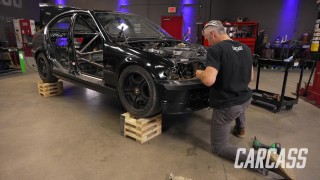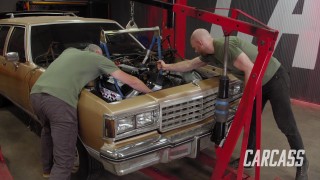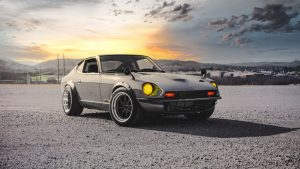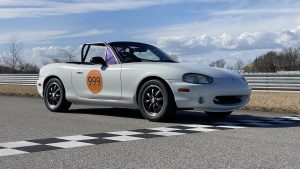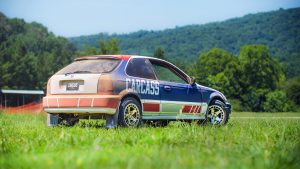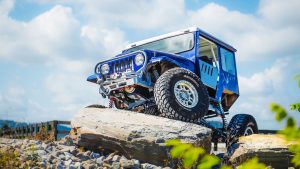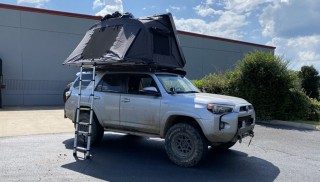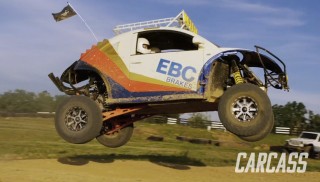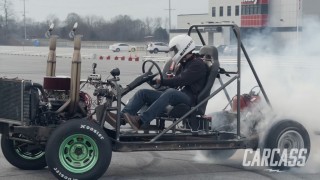Carcass Featured Projects
Carcass Builds
Want more content like this?
Join the PowerNation Email NewsletterEpisode Transcript
(Jeremy)>> You're watching Powernation!
(Jimmy)>> Today on Carcass we bring our abandoned Chevy project back into the shop and give it a new e-f-i system that will give us tuneability so we can add some performance upgrades in the future.
(Jeremy)>> Plus we head out of the shop to Mid-Ohio Sports Car Course to catch up with the Auto Interest Group to get some track time with our Spec Panther Crown Vic. [ Music ]
Hey guys, Jeremy and Jimmy here from Carcass. Now some of you may or may not remember what this project is. It's a '96 Silverado that we decided to turn into a daily driver. We put on a couple of new body panels. We fixed a couple of spots of rust in the back here, and we even put on a fresh coat of paint, but we also went to a local salvage yard and picked up a 5.3-liter LS engine that Jimmy put some parts in to get this thing running. On top of that we grabbed the stock wiring harness and the e-c-u to get this thing on the road.
(Jimmy)>> One of the challenges with an engine swap like this is the engine management system, and like Jeremy said, we went through the harness and stripped out everything that we didn't need and had the e-c-u flashed for our setup. But if you're not experienced in this area and maybe you cut a wire you weren't supposed to, or if you don't have the software to flash the e-c-u, your engine may not run. So, what we're doing today is swapping over to Edelbrock's complete engine management system to give us that simplicity and the tuneability for upgrades later on. And today we are lucky enough to have Mark Campbell from Edelbrock to talk about and help us install their new engine management system.
(Mark)>> Yeah, we have our new Pro Flow 4+ e-f-i system. Obviously works well with the LS like we're gonna do today, but also is fully compatible with the gen three Hemi and the Ford Coyote platform.
(Jimmy)>> And this thing can handle upgrades like if we want to do a cam, header swap, intake, stuff like that this has a self learning feature. So, it kinda automatically updates everything in there to make your engine run correctly.
(Mark)>> Absolutely, it just looks at the O-2 sensors. You put in what air/fuel ratio you're looking for. It automatically corrects and feeds all that data right back into the tables and makes all the necessary adjustments.
(Jimmy)>> And the setup sounds really easy because all we need is a tablet, or even an iPhone, just to download the app, and you just go through, pick your settings, and you're kinda on your way.
(Mark)>> Absolutely, Apple or Android device. So, you can use your iPhone or whatever telephone you have that you want to use. A simple download of that app, and plugging it in, and go. There's a really nice, very simple setup menu. Answer a few questions and it's ready to go.
(Jimmy)>> And then you guys also offer a transmission control unit. We have a 4-L-60 in our truck. So, I imagine they play very nice together, and if you are swapping to an electronic transmission then you can set it up.
(Mark)>> Yeah, very, very simple. It's just one single can connection between the two boxes. The beauty of that is if you do do an upgrade you start with maybe a manual transmission or a non-electronic transmission, you can buy the box and the harness afterwards, set it up, and simple as can be.
(Jimmy)>> And relative to the old harness that's all stiff wires, and the conduit, and everything's kinda screwed up, but this stuff looks super durable. Everything you guys have it wrapped in looks really nice, and the connectors are really beefy, waterproof, I'm sure. We can mount these in the engine bay, under the truck? How does that all work?
(Mark)>> They're fully potted. So, they're 100 percent weatherproof. All the connectors same thing. They're all weather tight. So, you're good to go. You can literally mount it anywhere you want, and like you said. Much unlike the factory harness, brand new wire, nice and pliable, and easy to install.
(Jimmy)>> Nice, simple, looks clean. I think Jeremy's getting the old stuff off. So, we can take some of this over there and get started.
(Marc)>> Perfect!
(Jimmy)>> Alright, let's clean it up a little bit.
(Jeremy)>> Man there are a ton of wires in this truck.
(Jimmy)>> I think we did a decent job, but obviously this system will be way more capable.
(Jeremy)>> I've already got this side basically disconnected. Get the rest of it off that side and then we can start putting your harnesses on and we'll lay everything out. [ Music ] Is that it?
(Jimmy)>> Yep! Alright, old stuff is off. Where do we start?
(Mark)>> Probably just laying out the main harness for the injectors and all the bits and pieces that we've got to hook up here, and we can get it all laid out and start plugging it in.
(Jimmy)>> Cool, work our way down and backwards, sweet! [ Music ] I'm gonna sneak it under some stuff here. [ Music ] So, we just hooked up the coil harnesses, and this little harness also has a ground, cam sensor, and then also crank sensor will run down there. Some of this stuff we'll have to hook up later when we can get under the truck, but what harness after this one?
(Mark)>> Probably we'll start working with the coolant temperature, fuel pressure, all that. That's probably the next best choice.
(Jimmy)>> This one here?
(Mark)>> That's the one!
(Jimmy)>> Let me get this spread out a little bit and see what we're looking at.
(Mark)>> Nice thing is everything's labeled. Makes it simple. [ Music ]
(Jimmy)>> At this point we have the main harness kinda laid over the engine, got everything plugged in. What's the next thing?
(Mark)>> May as well tackle the fuel system. We just had to add the little adapter in there so we can get fuel pressure off of here. So, you can hand me that adapter and we'll put that on. [ Music ]
Alright, well we got the fuel system, the fuel pressure all buttoned up. So, I guess the next step is we can get mounting the computer.
(Jimmy)>> Any way not to mount this?
(Mark)>> Really it's fairly versatile but we prefer not for it to be mounted with the plugs facing upwards. It is a sealed connection, but if you can mount it with those plugs facing down, or at least on a flat space that works really good.
(Jimmy)>> I think we'll just go on the inner fender here. A lot of space over here and easy enough to get a self tapping screw in it.
(Mark)>> That'll work perfect. [ drill humming ]
(Jimmy)>> So we'll get this one in, and then also mount the transmission control unit. Kind of the same deal.
(Mark)>> I'll do it right beside there. [ drill humming ] [ Music ]
(Mark)>> Alright, well we got the rest of the accessory harness here. So that'll get plugged into the computer. This can run over here for our fuel pumps, and a couple of other items we've got to wire in.
(Jimmy)>> And this is set up for fans too.
(Mark)>> Yeah, so over there you're gonna have a connection where you can actually power up your electric fans as well.
(Jimmy)>> We're lucky enough to run a mechanical but most people I would say are running aftermarket radiator, shroud, fans, the whole deal.
(Mark)>> And then your main power and ground are over there as well, which will go right to the battery, which is beside you, and a couple of the relays that control the fuel pump, and the fans, and other things. So, it's all built into the harness, which is really nice.
(Jimmy)>> Yeah, that's awesome! [ Music ] Alright, looks like that harness is set up. Got battery cables running over here.
(Mark)>> So we've got our O-2 extension and our O-2. We can hook this up. You can run that through, drop it down, and then once we get the truck up in the air and do the transmission harness, we can plug this in as well.
(Jimmy)>> Cool! [ Music ]
(Jeremy)>> How are you guys doing?
(Mark)>> Getting a lot done here for sure.
(Jeremy)>> It looks like you've got mostly everything buttoned up.
(Mark)>> Yep, we've just got a little bit left here to do. We've got to run this through the firewall, hook up to the pedal, a couple of other little switch power tach and brake light switch.
(Jeremy)>> I'll take care of that. I'll go under the dash here and I can make those connections. [ Music ] Alright, I've got the wires.
(Mark)>> Got the wires there, perfect!
(Jimmy)>> And then what's next up here?
(Mark)>> We could probably go ahead and start getting everything ready for the throttle body, get the cold air intake off, and start bolting that on. [ ratchet clicking ]
(Jimmy)>> So there's a specific throttle body and pedal for your guys' system, right?
(Mark)>> Yeah, so we list all the other parts that you'd need on our website with the kits. Right here we have the correct pedal to put on the truck. So, if you can hand this over to Jeremy he can...
(Jeremy)>> There's only a couple of things I have to do under here. Just a couple of connections and I'll get this in as well.
(Mark)>> Awesome!
(Jeremy)>> So under the dash here we only have a couple of things to wrap up. Obviously, we've got to install the throttle pedal, and then we have just a couple of wires. One of them is for the brake switch for the transmission. One is pink. That's the key on hot source, and they even give you a tach wire if you guys want to hook up the stock tach. So, we'll go ahead and get all this wired in. Then we'll transition underneath the truck and get this thing wrapped up.
(Jimmy)>> We finish up the install of our e-f-i system and fire up the old Chevy.
(Jeremy)>> Hey guys, well we're back working on the Pro Flow 4+ system in our Silverado. We've only got a couple more connections to make. One of them is on the engine side. That's the oxygen sensor. Once we get this installed, we'll go ahead and jump to the transmission side of things, and that's pretty simple too, right?
(Mark)>> Absolutely! [ Music ]
(Jeremy)>> Well that buttons up everything on the engine side of things, and this is the harness for your transmission controller, right?
(Mark)>> Yeah, so the separate box that we have to control the automatic transmission. We have the main wiring harness here that'll plug in. We also have the rear speed sensor that goes into it, and to hook up to the speedometer.
(Jeremy)>> And this is an optional wire, right? You don't have to run this?
(Mark)>> For sure.
(Jeremy)>> This will make the speedo work in the truck.
(Mark)>> Absolutely, and then one other wire here. If you do have four wheel drive control the transfer case.
(Jeremy)>> I'll find the harness for the speedo side in the truck, and you can hook those up. [ Music ] Well, I think that buttons up the install, right?
(Mark)>> I think so.
(Jeremy)>> We've just got to get it down on the ground and program the app for the engine and the transmission side of things?
(Mark)>> Yep, and we should be able to make some noise.
(Jeremy)>> Let's get it on the ground and see what we can do. [ Music ] Alright guys, we'll I think we're ready to fire this thing up, but before we can actually turn the key and start it we do have to do a little bit of programming, right?
(Mark)>> Absolutely. If you key it on I'll get this thing connected, and it'll just take a second for that, and then we can get it setup.
(Jeremy)>> While that's loading, or connecting, why don't you tell us a little bit about your new facility out in Olive Branch.
(Mark)>> Yeah, we recently just renovated our building. We now have our headquarters in Olive Branch, Mississippi. Really excited about that. All of our sales team, engineering, everybody's all there, and we have manifold production as well. So pretty excited to be there. It's a new chapter in Edelbrock and we're very excited.
(Jeremy)>> And it's not too far from where we are. Maybe we'll have to drive the truck down and check it out sometime.
(Mark)>> You guys are welcome any time.
(Jeremy)>> Awesome, and when that's connected we've got a couple of things that we just need to input to get this thing running.
(Mark)>> Yeah, basic information on the engine, couple of little screens, and we'll have this thing running.
(Jeremy)>> Let's do that.
(Mark)>> So we've got the check mark on the engines. So, we're all connected. So, we're gonna hit the setup wizard here. This is just the base map here. So, we're gonna start the wizard, yes. We're gonna start fresh. So obviously we have a Chevrolet LS. We have one O-2 sensor. You do have the option to put two in there. So, we're good there. This is a 24-X reluctor wheel on the crankshaft on this engine. That is the throttle pedal that we've put into the truck. So, we're good there. It is a single throttle body. This will also control dual drive by wire throttle bodies. It is the gold colored throttle plate. There is also a silver one, but this is gold on here. So, we're good, and it is actually a four pin alternator on this particular engine. So that's good. Next step, we do have a resonance style knock sensor in this engine. So, we'll select that, and it is a 5.3. So, 323, 325 cubic inches, right in that area. That's good! It is just a stock cam in this particular engine. So really easy there. You do have a couple of other choices. It is a stock 26-pound injector in this engine, and basically that's it. So, you can see it's loading the tune into the computer now. As soon as that's done we can go to the next table and start the engine up. Alright, key on, ready, fire it up! [ engine cranking ] [ engine starting ]
(Jeremy)>> Simple as that right?
(Mark)>> Absolutely. Just step on the brake once to check the brake light switch to make sure it works. Everything looks good. Idle's set at 800. That should be good.
(Jeremy)>> It's running great! We're all set, as simple as that.
(Mark)>> Shows all the stuff that's happening, runs.
(Jeremy)>> And it's running great!
(Mark)>> Basically all we have to do now is just go drive it.
(Jeremy)>> So this is a self learning setup. So, the more you drive it the better it's gonna run, the more it's gonna learn, and get better at everything as it goes along. Well, that's pretty awesome. I mean I think we're good.
(Mark)>> Simple as can be.
(Jeremy)>> Well we're super thankful for you guys coming in. The setup was awesome, and obviously we always love the help getting this stuff put on here. So maybe we'll have to get this back on the road. We'll get the hood on, and we'll come down and see you guys in Olive Branch.
(Mark)>> That'll be awesome! You're welcome any time you want to come.
(Jeremy)>> That's great! Turned out really good. coming up, we check out a great beginner race series that's easy on your wallet.
(Jimmy)>> Jeremy and I are out of the shop today and out here at Mid-Ohio Sports Car Course to do some driving with the Auto Interest Group and our Spec Panther. They have their Spec Panther class here today, and it is a little wet and damp on track but it should be a good challenge for us.
(Jeremy)>> And you guys haven't seen this car before this is our 2008 Ford Crown Vic. It's considered a Panther chassis. Hence why we run in the Spec Panther group. It is a little wet like Jimmy said. It's actually raining just a little bit, but we're not racing today. We're just here to figure out the best lines to take, and how fast you can really drive on the course. Jimmy's in the hot seat. I'm just a spectator. So, he's gonna go lay down some fast times. Hop in. [ tires squealing ] [ engine revving ]
(Jimmy)>> The Auto Interest group formed the Spec Panther competitive race series two years ago to encourage drive skill development through their HPDE program. The series aims to give anyone that has a passion for driving fast the ability to do so without the costly modifications to their vehicles. Plus, the opportunity to hone in their skills on the racecourse.
(Rick)>> Spec Panther got started a couple of years ago we were just sitting around, and most the instructors have race cars, and they're kinda expensive to maintain, and keep on track, and keep them going. So, we kinda wanted to do something on a budget. We were getting bored going super fast. So, we decided let's go faster than Miatas. Let's have something rear wheel drive, and cheap, and very plentiful. And we talked about a few different cars, and we ended up with the Panther platform, and most of us have Crown Vics, and we just come out and have a blast for almost no money.
(Alec)>> The price point's your best. You can drive it, drive the car to the track, beat on it all day, and drive it home. They're extremely reliable. Parts are readily available.
(Garret)>> I've always wanted to get into the racing scene, and this is the cheapest and easiest way to do it. You can find these things for next to nothing, and like I said, parts are plentiful and they don't break. They're tanks!
(Jimmy)>> While the Spec Panther series is an affordable and more accessible way to get on the track there was one side effect that came from their scheduled time trial events.
(Alec)>> Dollar for smiles you can't beat it.
(Derek)>> So a lot of these cars still have the sirens in them. So, we have fun on track with each other. So, we might put the sirens on on each other. A couple of them have lights hooked up too. So, you might see lights flashing in your mirror. It's just an overall fun time. Things that you can't do regularly on a racetrack.
(Rick)>> Spec Panther has more smiles per mile than any other race series I guarantee it.
(Garret)>> The Spec Panther series is great. Tons of fun per dollar with these cars. They're plentiful, they're robust, and what you can do with an experienced drive behind the wheel is something to behold. It blows your mind really. [ engine revving ]
(Jimmy)>> We hit the track in our Spec Panther Crown Vic to have some fun and improve our times.
(Jeremy)>> Now before Jimmy goes out onto the track we're gonna give him a little bit of help. This is a Garmin Catalyst. This is like a professional driving coach that's attached to your windshield, and it's just gonna help him set faster lap times as he drives. So, we'll go ahead, click on drive, click on mid-Ohio, and normal, hit start, and he's ready to go. [ engine revving ]
(Jimmy)>> So we're out on track, and one cool thing I have in the car with me is the Garmin Catalyst Driving Performance Optimizer. Of course, as racers we're always trying to find a little bit of time and be faster every lap, and this thing can collect data to help us do all of that. One thing that's really cool is they have a ton of major raceways already built into this by g-p-s. So, they can give us the proper racing line to take to make sure that we're doing a good job, and make sure that we can get the fastest time. [ engine revving ]
(Jimmy)>> Another thing that's really cool is that if you do have this hooked up to your car stereo or a headset inside your helmet it can give you real time feedback just to keep you on track and keep you on pace. And as you keep turning laps this thing is gonna tell you if you're behind your current pace or if you're actually improving, and that's just a great thing because lap by lap we just want to get that feedback constantly to make sure that we're doing a good job. And for me, with this being my first time on this track, I just don't really know what the proper racing line is. So instead of me wasting time trying to figure that out and just wasting laps the Catalyst can give me a really good starting point and I can just take my time, kinda work up to it, and then by the end of the day I will most likely be faster than if I didn't have this system. So, it's just really neat to have this kind of technology available because at the end of the day we're just trying to have fun out here and go fast. So whatever way we can do that that's good enough for me. And at the end of it this thing also records video. So, I can go back and watch stuff. Kinda give myself feedback on what I'm doing, and just try to be the best driver that I can. [ Music ]
(Jeremy)>> Well we've had a bunch of fun at the racetrack so far, but the weather has moved in and it's starting to rain a little bit. So, we're gonna go ahead and cover up the Spec Panther with a car cover that we got from CoverCraft. This is their Weather Shield HP. Our cover is made of a durable lightweight high performance fabric. It allows heat and moisture to escape easily. It provides superior paint protection against sun, rain, dust, and more. The cover has excellent water dispersion, which means as soon as water hits it, it beads right off. Plus, it's an exact fit for our Crown Vic. And as an added bonus we got our customized with 19 on the side and Sea Foam on the top. Well, the rain's kinda moved. So that's gonna wrap it up for us today.
(Jimmy)>> So if you guys like anything you've seen today be sure to check out Powernation TV and we'll see you next time.
(Jeremy)>> The rain really beads off this thing!
Show Full Transcript
(Jimmy)>> Today on Carcass we bring our abandoned Chevy project back into the shop and give it a new e-f-i system that will give us tuneability so we can add some performance upgrades in the future.
(Jeremy)>> Plus we head out of the shop to Mid-Ohio Sports Car Course to catch up with the Auto Interest Group to get some track time with our Spec Panther Crown Vic. [ Music ]
Hey guys, Jeremy and Jimmy here from Carcass. Now some of you may or may not remember what this project is. It's a '96 Silverado that we decided to turn into a daily driver. We put on a couple of new body panels. We fixed a couple of spots of rust in the back here, and we even put on a fresh coat of paint, but we also went to a local salvage yard and picked up a 5.3-liter LS engine that Jimmy put some parts in to get this thing running. On top of that we grabbed the stock wiring harness and the e-c-u to get this thing on the road.
(Jimmy)>> One of the challenges with an engine swap like this is the engine management system, and like Jeremy said, we went through the harness and stripped out everything that we didn't need and had the e-c-u flashed for our setup. But if you're not experienced in this area and maybe you cut a wire you weren't supposed to, or if you don't have the software to flash the e-c-u, your engine may not run. So, what we're doing today is swapping over to Edelbrock's complete engine management system to give us that simplicity and the tuneability for upgrades later on. And today we are lucky enough to have Mark Campbell from Edelbrock to talk about and help us install their new engine management system.
(Mark)>> Yeah, we have our new Pro Flow 4+ e-f-i system. Obviously works well with the LS like we're gonna do today, but also is fully compatible with the gen three Hemi and the Ford Coyote platform.
(Jimmy)>> And this thing can handle upgrades like if we want to do a cam, header swap, intake, stuff like that this has a self learning feature. So, it kinda automatically updates everything in there to make your engine run correctly.
(Mark)>> Absolutely, it just looks at the O-2 sensors. You put in what air/fuel ratio you're looking for. It automatically corrects and feeds all that data right back into the tables and makes all the necessary adjustments.
(Jimmy)>> And the setup sounds really easy because all we need is a tablet, or even an iPhone, just to download the app, and you just go through, pick your settings, and you're kinda on your way.
(Mark)>> Absolutely, Apple or Android device. So, you can use your iPhone or whatever telephone you have that you want to use. A simple download of that app, and plugging it in, and go. There's a really nice, very simple setup menu. Answer a few questions and it's ready to go.
(Jimmy)>> And then you guys also offer a transmission control unit. We have a 4-L-60 in our truck. So, I imagine they play very nice together, and if you are swapping to an electronic transmission then you can set it up.
(Mark)>> Yeah, very, very simple. It's just one single can connection between the two boxes. The beauty of that is if you do do an upgrade you start with maybe a manual transmission or a non-electronic transmission, you can buy the box and the harness afterwards, set it up, and simple as can be.
(Jimmy)>> And relative to the old harness that's all stiff wires, and the conduit, and everything's kinda screwed up, but this stuff looks super durable. Everything you guys have it wrapped in looks really nice, and the connectors are really beefy, waterproof, I'm sure. We can mount these in the engine bay, under the truck? How does that all work?
(Mark)>> They're fully potted. So, they're 100 percent weatherproof. All the connectors same thing. They're all weather tight. So, you're good to go. You can literally mount it anywhere you want, and like you said. Much unlike the factory harness, brand new wire, nice and pliable, and easy to install.
(Jimmy)>> Nice, simple, looks clean. I think Jeremy's getting the old stuff off. So, we can take some of this over there and get started.
(Marc)>> Perfect!
(Jimmy)>> Alright, let's clean it up a little bit.
(Jeremy)>> Man there are a ton of wires in this truck.
(Jimmy)>> I think we did a decent job, but obviously this system will be way more capable.
(Jeremy)>> I've already got this side basically disconnected. Get the rest of it off that side and then we can start putting your harnesses on and we'll lay everything out. [ Music ] Is that it?
(Jimmy)>> Yep! Alright, old stuff is off. Where do we start?
(Mark)>> Probably just laying out the main harness for the injectors and all the bits and pieces that we've got to hook up here, and we can get it all laid out and start plugging it in.
(Jimmy)>> Cool, work our way down and backwards, sweet! [ Music ] I'm gonna sneak it under some stuff here. [ Music ] So, we just hooked up the coil harnesses, and this little harness also has a ground, cam sensor, and then also crank sensor will run down there. Some of this stuff we'll have to hook up later when we can get under the truck, but what harness after this one?
(Mark)>> Probably we'll start working with the coolant temperature, fuel pressure, all that. That's probably the next best choice.
(Jimmy)>> This one here?
(Mark)>> That's the one!
(Jimmy)>> Let me get this spread out a little bit and see what we're looking at.
(Mark)>> Nice thing is everything's labeled. Makes it simple. [ Music ]
(Jimmy)>> At this point we have the main harness kinda laid over the engine, got everything plugged in. What's the next thing?
(Mark)>> May as well tackle the fuel system. We just had to add the little adapter in there so we can get fuel pressure off of here. So, you can hand me that adapter and we'll put that on. [ Music ]
Alright, well we got the fuel system, the fuel pressure all buttoned up. So, I guess the next step is we can get mounting the computer.
(Jimmy)>> Any way not to mount this?
(Mark)>> Really it's fairly versatile but we prefer not for it to be mounted with the plugs facing upwards. It is a sealed connection, but if you can mount it with those plugs facing down, or at least on a flat space that works really good.
(Jimmy)>> I think we'll just go on the inner fender here. A lot of space over here and easy enough to get a self tapping screw in it.
(Mark)>> That'll work perfect. [ drill humming ]
(Jimmy)>> So we'll get this one in, and then also mount the transmission control unit. Kind of the same deal.
(Mark)>> I'll do it right beside there. [ drill humming ] [ Music ]
(Mark)>> Alright, well we got the rest of the accessory harness here. So that'll get plugged into the computer. This can run over here for our fuel pumps, and a couple of other items we've got to wire in.
(Jimmy)>> And this is set up for fans too.
(Mark)>> Yeah, so over there you're gonna have a connection where you can actually power up your electric fans as well.
(Jimmy)>> We're lucky enough to run a mechanical but most people I would say are running aftermarket radiator, shroud, fans, the whole deal.
(Mark)>> And then your main power and ground are over there as well, which will go right to the battery, which is beside you, and a couple of the relays that control the fuel pump, and the fans, and other things. So, it's all built into the harness, which is really nice.
(Jimmy)>> Yeah, that's awesome! [ Music ] Alright, looks like that harness is set up. Got battery cables running over here.
(Mark)>> So we've got our O-2 extension and our O-2. We can hook this up. You can run that through, drop it down, and then once we get the truck up in the air and do the transmission harness, we can plug this in as well.
(Jimmy)>> Cool! [ Music ]
(Jeremy)>> How are you guys doing?
(Mark)>> Getting a lot done here for sure.
(Jeremy)>> It looks like you've got mostly everything buttoned up.
(Mark)>> Yep, we've just got a little bit left here to do. We've got to run this through the firewall, hook up to the pedal, a couple of other little switch power tach and brake light switch.
(Jeremy)>> I'll take care of that. I'll go under the dash here and I can make those connections. [ Music ] Alright, I've got the wires.
(Mark)>> Got the wires there, perfect!
(Jimmy)>> And then what's next up here?
(Mark)>> We could probably go ahead and start getting everything ready for the throttle body, get the cold air intake off, and start bolting that on. [ ratchet clicking ]
(Jimmy)>> So there's a specific throttle body and pedal for your guys' system, right?
(Mark)>> Yeah, so we list all the other parts that you'd need on our website with the kits. Right here we have the correct pedal to put on the truck. So, if you can hand this over to Jeremy he can...
(Jeremy)>> There's only a couple of things I have to do under here. Just a couple of connections and I'll get this in as well.
(Mark)>> Awesome!
(Jeremy)>> So under the dash here we only have a couple of things to wrap up. Obviously, we've got to install the throttle pedal, and then we have just a couple of wires. One of them is for the brake switch for the transmission. One is pink. That's the key on hot source, and they even give you a tach wire if you guys want to hook up the stock tach. So, we'll go ahead and get all this wired in. Then we'll transition underneath the truck and get this thing wrapped up.
(Jimmy)>> We finish up the install of our e-f-i system and fire up the old Chevy.
(Jeremy)>> Hey guys, well we're back working on the Pro Flow 4+ system in our Silverado. We've only got a couple more connections to make. One of them is on the engine side. That's the oxygen sensor. Once we get this installed, we'll go ahead and jump to the transmission side of things, and that's pretty simple too, right?
(Mark)>> Absolutely! [ Music ]
(Jeremy)>> Well that buttons up everything on the engine side of things, and this is the harness for your transmission controller, right?
(Mark)>> Yeah, so the separate box that we have to control the automatic transmission. We have the main wiring harness here that'll plug in. We also have the rear speed sensor that goes into it, and to hook up to the speedometer.
(Jeremy)>> And this is an optional wire, right? You don't have to run this?
(Mark)>> For sure.
(Jeremy)>> This will make the speedo work in the truck.
(Mark)>> Absolutely, and then one other wire here. If you do have four wheel drive control the transfer case.
(Jeremy)>> I'll find the harness for the speedo side in the truck, and you can hook those up. [ Music ] Well, I think that buttons up the install, right?
(Mark)>> I think so.
(Jeremy)>> We've just got to get it down on the ground and program the app for the engine and the transmission side of things?
(Mark)>> Yep, and we should be able to make some noise.
(Jeremy)>> Let's get it on the ground and see what we can do. [ Music ] Alright guys, we'll I think we're ready to fire this thing up, but before we can actually turn the key and start it we do have to do a little bit of programming, right?
(Mark)>> Absolutely. If you key it on I'll get this thing connected, and it'll just take a second for that, and then we can get it setup.
(Jeremy)>> While that's loading, or connecting, why don't you tell us a little bit about your new facility out in Olive Branch.
(Mark)>> Yeah, we recently just renovated our building. We now have our headquarters in Olive Branch, Mississippi. Really excited about that. All of our sales team, engineering, everybody's all there, and we have manifold production as well. So pretty excited to be there. It's a new chapter in Edelbrock and we're very excited.
(Jeremy)>> And it's not too far from where we are. Maybe we'll have to drive the truck down and check it out sometime.
(Mark)>> You guys are welcome any time.
(Jeremy)>> Awesome, and when that's connected we've got a couple of things that we just need to input to get this thing running.
(Mark)>> Yeah, basic information on the engine, couple of little screens, and we'll have this thing running.
(Jeremy)>> Let's do that.
(Mark)>> So we've got the check mark on the engines. So, we're all connected. So, we're gonna hit the setup wizard here. This is just the base map here. So, we're gonna start the wizard, yes. We're gonna start fresh. So obviously we have a Chevrolet LS. We have one O-2 sensor. You do have the option to put two in there. So, we're good there. This is a 24-X reluctor wheel on the crankshaft on this engine. That is the throttle pedal that we've put into the truck. So, we're good there. It is a single throttle body. This will also control dual drive by wire throttle bodies. It is the gold colored throttle plate. There is also a silver one, but this is gold on here. So, we're good, and it is actually a four pin alternator on this particular engine. So that's good. Next step, we do have a resonance style knock sensor in this engine. So, we'll select that, and it is a 5.3. So, 323, 325 cubic inches, right in that area. That's good! It is just a stock cam in this particular engine. So really easy there. You do have a couple of other choices. It is a stock 26-pound injector in this engine, and basically that's it. So, you can see it's loading the tune into the computer now. As soon as that's done we can go to the next table and start the engine up. Alright, key on, ready, fire it up! [ engine cranking ] [ engine starting ]
(Jeremy)>> Simple as that right?
(Mark)>> Absolutely. Just step on the brake once to check the brake light switch to make sure it works. Everything looks good. Idle's set at 800. That should be good.
(Jeremy)>> It's running great! We're all set, as simple as that.
(Mark)>> Shows all the stuff that's happening, runs.
(Jeremy)>> And it's running great!
(Mark)>> Basically all we have to do now is just go drive it.
(Jeremy)>> So this is a self learning setup. So, the more you drive it the better it's gonna run, the more it's gonna learn, and get better at everything as it goes along. Well, that's pretty awesome. I mean I think we're good.
(Mark)>> Simple as can be.
(Jeremy)>> Well we're super thankful for you guys coming in. The setup was awesome, and obviously we always love the help getting this stuff put on here. So maybe we'll have to get this back on the road. We'll get the hood on, and we'll come down and see you guys in Olive Branch.
(Mark)>> That'll be awesome! You're welcome any time you want to come.
(Jeremy)>> That's great! Turned out really good. coming up, we check out a great beginner race series that's easy on your wallet.
(Jimmy)>> Jeremy and I are out of the shop today and out here at Mid-Ohio Sports Car Course to do some driving with the Auto Interest Group and our Spec Panther. They have their Spec Panther class here today, and it is a little wet and damp on track but it should be a good challenge for us.
(Jeremy)>> And you guys haven't seen this car before this is our 2008 Ford Crown Vic. It's considered a Panther chassis. Hence why we run in the Spec Panther group. It is a little wet like Jimmy said. It's actually raining just a little bit, but we're not racing today. We're just here to figure out the best lines to take, and how fast you can really drive on the course. Jimmy's in the hot seat. I'm just a spectator. So, he's gonna go lay down some fast times. Hop in. [ tires squealing ] [ engine revving ]
(Jimmy)>> The Auto Interest group formed the Spec Panther competitive race series two years ago to encourage drive skill development through their HPDE program. The series aims to give anyone that has a passion for driving fast the ability to do so without the costly modifications to their vehicles. Plus, the opportunity to hone in their skills on the racecourse.
(Rick)>> Spec Panther got started a couple of years ago we were just sitting around, and most the instructors have race cars, and they're kinda expensive to maintain, and keep on track, and keep them going. So, we kinda wanted to do something on a budget. We were getting bored going super fast. So, we decided let's go faster than Miatas. Let's have something rear wheel drive, and cheap, and very plentiful. And we talked about a few different cars, and we ended up with the Panther platform, and most of us have Crown Vics, and we just come out and have a blast for almost no money.
(Alec)>> The price point's your best. You can drive it, drive the car to the track, beat on it all day, and drive it home. They're extremely reliable. Parts are readily available.
(Garret)>> I've always wanted to get into the racing scene, and this is the cheapest and easiest way to do it. You can find these things for next to nothing, and like I said, parts are plentiful and they don't break. They're tanks!
(Jimmy)>> While the Spec Panther series is an affordable and more accessible way to get on the track there was one side effect that came from their scheduled time trial events.
(Alec)>> Dollar for smiles you can't beat it.
(Derek)>> So a lot of these cars still have the sirens in them. So, we have fun on track with each other. So, we might put the sirens on on each other. A couple of them have lights hooked up too. So, you might see lights flashing in your mirror. It's just an overall fun time. Things that you can't do regularly on a racetrack.
(Rick)>> Spec Panther has more smiles per mile than any other race series I guarantee it.
(Garret)>> The Spec Panther series is great. Tons of fun per dollar with these cars. They're plentiful, they're robust, and what you can do with an experienced drive behind the wheel is something to behold. It blows your mind really. [ engine revving ]
(Jimmy)>> We hit the track in our Spec Panther Crown Vic to have some fun and improve our times.
(Jeremy)>> Now before Jimmy goes out onto the track we're gonna give him a little bit of help. This is a Garmin Catalyst. This is like a professional driving coach that's attached to your windshield, and it's just gonna help him set faster lap times as he drives. So, we'll go ahead, click on drive, click on mid-Ohio, and normal, hit start, and he's ready to go. [ engine revving ]
(Jimmy)>> So we're out on track, and one cool thing I have in the car with me is the Garmin Catalyst Driving Performance Optimizer. Of course, as racers we're always trying to find a little bit of time and be faster every lap, and this thing can collect data to help us do all of that. One thing that's really cool is they have a ton of major raceways already built into this by g-p-s. So, they can give us the proper racing line to take to make sure that we're doing a good job, and make sure that we can get the fastest time. [ engine revving ]
(Jimmy)>> Another thing that's really cool is that if you do have this hooked up to your car stereo or a headset inside your helmet it can give you real time feedback just to keep you on track and keep you on pace. And as you keep turning laps this thing is gonna tell you if you're behind your current pace or if you're actually improving, and that's just a great thing because lap by lap we just want to get that feedback constantly to make sure that we're doing a good job. And for me, with this being my first time on this track, I just don't really know what the proper racing line is. So instead of me wasting time trying to figure that out and just wasting laps the Catalyst can give me a really good starting point and I can just take my time, kinda work up to it, and then by the end of the day I will most likely be faster than if I didn't have this system. So, it's just really neat to have this kind of technology available because at the end of the day we're just trying to have fun out here and go fast. So whatever way we can do that that's good enough for me. And at the end of it this thing also records video. So, I can go back and watch stuff. Kinda give myself feedback on what I'm doing, and just try to be the best driver that I can. [ Music ]
(Jeremy)>> Well we've had a bunch of fun at the racetrack so far, but the weather has moved in and it's starting to rain a little bit. So, we're gonna go ahead and cover up the Spec Panther with a car cover that we got from CoverCraft. This is their Weather Shield HP. Our cover is made of a durable lightweight high performance fabric. It allows heat and moisture to escape easily. It provides superior paint protection against sun, rain, dust, and more. The cover has excellent water dispersion, which means as soon as water hits it, it beads right off. Plus, it's an exact fit for our Crown Vic. And as an added bonus we got our customized with 19 on the side and Sea Foam on the top. Well, the rain's kinda moved. So that's gonna wrap it up for us today.
(Jimmy)>> So if you guys like anything you've seen today be sure to check out Powernation TV and we'll see you next time.
(Jeremy)>> The rain really beads off this thing!







